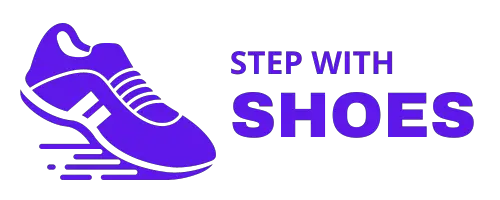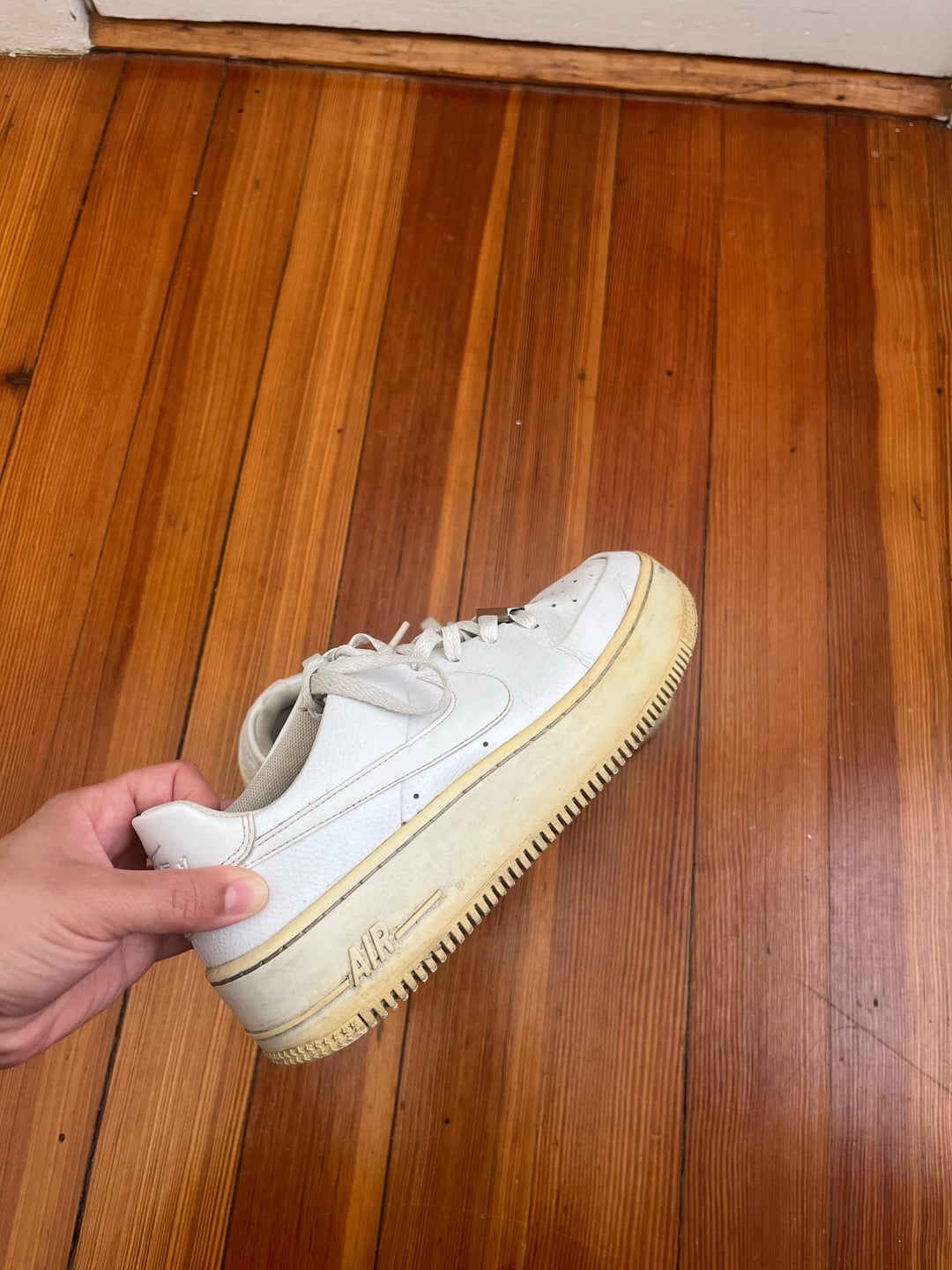Downsizing climbing shoes can improve performance, but it can also cause pain. How do you know if you’ve gone too far?
Finding the right fit for climbing shoes is crucial. Shoes that are too tight can hurt and affect your climbing experience. Many climbers downsize to get better grip and control. But how small is too small? It’s a tricky balance.
This guide will help you figure out if your shoes are just right or if you need to reconsider your size choice. Learn the signs of overly tight shoes and how to pick the perfect fit for your climbing needs. Don’t let discomfort hold you back from enjoying your climbs.
Signs Your Climbing Shoes Are Too Small
Wearing the right size climbing shoes is crucial for both comfort and performance. But how can you tell if you’ve downsized too much? Here are some signs your climbing shoes are too small.
Pain And Discomfort
If you feel pain as soon as you put on your climbing shoes, they might be too small. Your feet should not hurt. A snug fit is good, but pain is not. Pay attention to any sharp or throbbing pains in your feet. Constant discomfort can affect your climbing performance.
| Type of Pain | Possible Cause |
|---|---|
| Shooting Pain | Shoes are too tight |
| Throbbing Pain | Restricted blood flow |
Toe Cramping
Toe cramping is another clear sign. If your toes are cramping during or after climbing, your shoes are too small. Your toes should be slightly curled but not crammed. Cramping can lead to long-term foot issues. Always check the fit before and after each climb.
- Check for red marks on your toes.
- Watch for swelling.
- Pay attention to any tingling sensations.
By keeping an eye on these signs, you can ensure your climbing shoes fit well. This will help you enjoy climbing without unnecessary pain or discomfort.
Impact On Climbing Performance
Wearing climbing shoes that are too tight can have a negative impact on your performance. While a snug fit is essential, over-tightening can lead to several issues. These can affect your climbing ability and overall experience. Let’s look at some key areas where downsizing too much can cause problems.
Loss Of Sensitivity
One major issue with overly tight shoes is the loss of sensitivity. Sensitivity allows you to feel the rock under your feet. This is crucial for precise foot placement. When shoes are too tight, they compress your feet too much. This reduces the natural feedback you get from the rock. Consequently, you might find it harder to make accurate movements.
Consider this: with reduced sensitivity, you may miss small holds. Your toes may not grip as well, leading to slips and falls. This is especially problematic on technical climbs where precision is key.
Reduced Flexibility
Another drawback of tight shoes is reduced flexibility. Flexibility in climbing shoes allows your feet to move naturally. It helps in maintaining balance and adapting to different surfaces. Tight shoes restrict this movement.
Here are some issues caused by reduced flexibility:
- Difficulty in smearing on slabs
- Increased strain on your feet
- Pain and discomfort during long climbs
Having shoes that are too rigid can also lead to quicker fatigue. Your feet will work harder to maintain grip, which can tire you out faster.
Physical Symptoms To Watch For
Downsizing climbing shoes can enhance performance. But, too tight shoes can cause problems. Watch for physical symptoms to know if your shoes are too small. These signs can help you make better choices for your feet and climbing experience.
Blisters And Calluses
Blisters often form from friction. Tight shoes increase this friction. You may feel burning or see red spots. These can turn into blisters. Calluses are thicker skin areas. They develop over time from repeated pressure. Both indicate your shoes might be too tight.
Nail Damage
Nail damage is another sign. Nails may turn black or blue. This happens when shoes press too much on your toes. You might also experience nail lifting. Pain under the nails is common. These symptoms suggest your shoes need resizing.

Credit: www.reddit.com
Comparing Different Shoe Brands
When choosing climbing shoes, understanding differences between brands is crucial. Different brands have unique sizing and materials. This makes finding the perfect fit challenging. In this section, we will compare shoe brands. This will help you determine if your downsizing is too much.
Sizing Variations
Each shoe brand has its own sizing chart. One brand’s size 10 might fit like another brand’s size 9. This inconsistency can confuse climbers. Trying on shoes from various brands helps. It allows you to see how each fits your foot. Pay attention to toe space and heel fit.
Material Differences
Materials used in climbing shoes vary greatly. Some brands use leather. Others use synthetic materials. Leather shoes often stretch over time. This means they might feel tight at first but become more comfortable. Synthetic materials stretch less. They maintain their original shape better. Know the material of your shoes. This helps you predict how they will wear in.
Tips For Finding The Right Fit
Finding the right fit for climbing shoes is crucial. Shoes that are too tight can be painful and ineffective. Shoes that are too loose can cause slipping and lack of control. Here are some tips to ensure you get the perfect fit for your climbing shoes.
Trying Different Sizes
Always try different sizes. Visit a store and try multiple sizes. Your street shoe size might not be your climbing shoe size. Climbing shoes are designed to fit snugly. Try half sizes and even quarter sizes if available. Remember, different brands have different sizing charts. Always check the brand’s specific size guide.
Checking Heel Fit
The heel fit is vital for performance. Your heel should not slip out when you climb. How to check: Stand on your toes and press your heel down. If your heel slips out, the shoe is too big. The heel should feel snug but not painful. If it pinches, it’s too tight.
| Size | Heel Fit | Comfort |
|---|---|---|
| Too Small | Pinches | Uncomfortable |
| Perfect Fit | Snug | Comfortable |
| Too Big | Slips Out | Loose |
- Try shoes at the end of the day. Feet swell throughout the day.
- Wear climbing socks if you use them. This affects the fit.
- Walk around the store. Test the comfort and fit.
By following these tips, you can find the right fit for your climbing shoes. A proper fit ensures comfort and enhances performance.
Breaking In New Climbing Shoes
Breaking in new climbing shoes can be a tricky process. Tight shoes offer better grip and control. Yet, they can cause discomfort if downsized too much. Finding the right balance is key. Let’s explore some helpful tips to break in your new climbing shoes.
Gradual Wear
Start by wearing your climbing shoes for short periods. Do this around the house or during light climbing sessions. This helps the material stretch slowly. Gradual wear prevents sudden pain or injury. Aim for 15-20 minutes at first. Then, increase the time as your shoes start to mold to your feet.
Using Socks
Wearing thin socks can help ease the break-in process. Socks add a small layer between your foot and the shoe. This can reduce friction and blisters. Start with thin socks. Gradually switch to thicker ones if necessary. Keep in mind, socks may slightly reduce sensitivity. So, use them only during the initial break-in phase.
When To Replace Your Climbing Shoes
Knowing when to replace your climbing shoes can save you from discomfort and injury. Over time, shoes wear out, and their performance declines. Understanding the signs can help you make a timely decision.
Signs Of Wear
Inspect your shoes regularly for visible damage. Here are key signs to look for:
- Holes in the Toe Box: Holes can affect your grip and comfort.
- Sole Delamination: The sole starts to separate from the shoe.
- Worn Out Rubber: The rubber loses its texture and stickiness.
- Stretched Upper Material: The shoe no longer fits snugly.
If you notice any of these signs, it might be time to get a new pair.
Loss Of Performance
Performance issues often indicate that it’s time for new climbing shoes. Here are some performance-related signs:
- Reduced Grip: Your shoes slip more often than before.
- Less Precision: You struggle with footholds that were easy previously.
- Decreased Sensitivity: You can’t feel the rock as well.
These issues can hinder your climbing experience and increase the risk of falls.
Regularly replacing your climbing shoes ensures that you stay safe and perform at your best.

Credit: www.reddit.com
Expert Recommendations
Choosing the right climbing shoes can be tricky. Especially if you downsize too much. Experts have shared some key recommendations. These tips can help you find the perfect fit. Learn from professionals and explore custom shoe options.
Professional Fit Advice
Professional climbers suggest a snug fit. But not too tight. Your toes should be slightly curled. Avoid shoes that cause sharp pain. This could mean they are too small. Walk around in the shoes. Check for any discomfort. A good fit should feel secure yet comfortable. Consult with store experts. They can offer personalized advice.
Custom Shoe Options
Many brands offer custom shoe options. This can be a great solution. Custom shoes match your foot shape. This ensures a better fit. Custom options can help if you have unique foot shapes. You can choose the right width and length. This minimizes the risk of downsizing too much. Ask brands about their custom services.

Credit: www.reddit.com
Frequently Asked Questions
How Can You Tell If Climbing Shoes Are Too Small?
Your toes will curl painfully. You may feel numbness. Red marks might appear after wearing.
Why Is It Bad To Downsize Climbing Shoes Too Much?
Too tight shoes can cause injuries. They may also reduce performance and comfort during climbs.
What Are Signs That Climbing Shoes Fit Properly?
Shoes should feel snug but not painful. Toes should slightly curl without severe discomfort. No numbness.
Conclusion
Finding the right fit for your climbing shoes is crucial. Too tight can cause pain and injury. Too loose affects performance. Listen to your feet. Check for numbness, blisters, or unbearable tightness. Comfort matters most. Test different sizes before buying.
Seek advice from experienced climbers. Proper fitting shoes enhance your climbing experience.



Leave a Reply